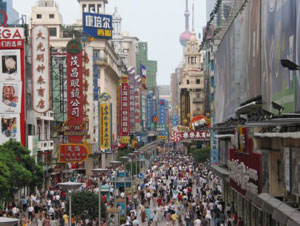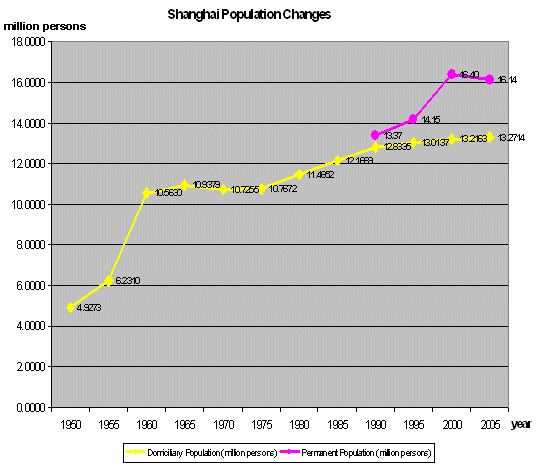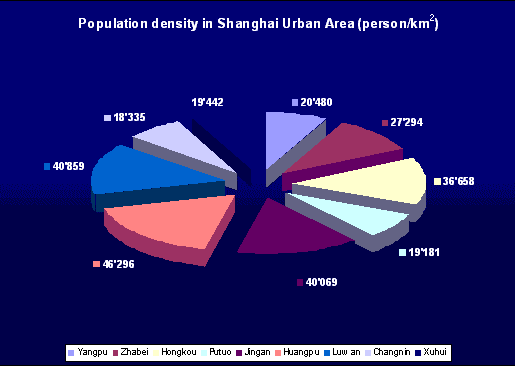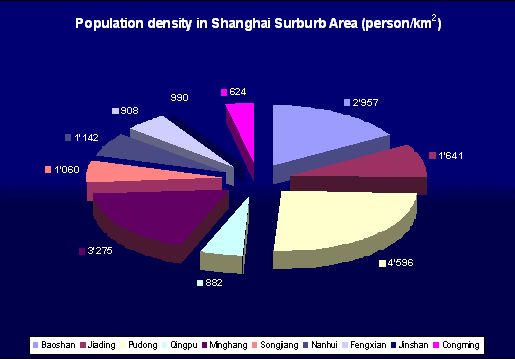
| ISSUE N° 2 May 2003 |
|||||||||||||||
|
Brief Report on Shanghai's Demography Download Shanghai Flash N° 2/2003 pdf-version Ranked the fifth most populous city in the world after Tokyo, Mexico City, Sao Paolo, and New York, the city of Shanghai is thus the biggest city in China. According to the fifth national population census conducted in the year 2000, Shanghai had a permanent population 16.41 million persons, an increase of 3.07 million persons over 1990. The increase rate of Shanghai's population, 23%, was much higher than the national average of 11.7%. The natural growth rate in Shanghai has been negative for the last 8 years. This means that the strong population increase of the city is exclusively due to immigration. Population is the principal factor and the major constraint for China's economic and social development. Shanghai is no exception, especially when taking into consideration that the city is playing more and more important roles in the regional economy, business, and culture. Shanghai's demographic situation is characterised by factors such as the large scale of population, the increasing floating population, the relatively low level of education and well-being, the ageing of the population, its uneven population distribution, and so on. In order to solve the demographic problems and to promote social and economic development, the Shanghai government has made a series of important policy decisions concerning family planning, employment, social security and population distribution.
General Situation and Problems of Shanghai Demographic Population issues include not only the size of population, but also educational and social well-being, age structure, and population distribution among other elements. The adequate size of the municipal population, its education level and a well-proportioned age structure and demographic distribution are all very important elements for the development of the inhabitants well-being. 1 Population changes Shanghai's population has undergone a fast growth in recent years even though the city has had a negative natural growth rate during the last years. By 2000, the permanent population in Shanghai had reached 16.41 million persons. 13. 21 million are inhabitants with a Shanghainese citizenship, 3. 87 million are inhabitants with a permanent residence status, living here for more than six months. The real numbers of the floating population not included in the permanent resident number are not really known. The floating population is only registered with the local security offices when the members stay in the city for longer than a month. in the city. They are regarded as residents when they stay longer than six months. Due to the promising development and lessening restrictions of policy concerning resident status, Shanghai has attracted more migrants year by year. There were 1.06 million migrants in Shanghai in 1988 while the amount of migrants had soared to the actual number of nearly 4 million people for the year 2000. Shanghai has thus become one of three main migration centres, together with Beijing and Guangzhou.
The statistics of the fifth national population census in the year 2000 shows a birth rate of 5.5‰, the death rate being 5.8‰, resulting in a negative natural growth rate of -0.3‰. The negative growth rate is a phenomenon of the last eight years. Shanghai is the only provincial administrative district among China's 31 provinces and regions showing a negative natural growth rate. It is mainly due to social and economic factors, but also due to some legal restraints on childbirth. These legal obstacles have been considerably lessened in order to propagate a positive natural growth rate among the residents, actually not with much success, as the statistics prove. The effects of urbanisation on Shanghai's population are very obvious and present the first such phenomenon on the Chinese mainland. The size of the population has created problems in different fields like employment, environment protection, and economic and social development. In 2001, the per capital GDP of Shanghai was only RMB 37205 ($ 4,500), even though the GDP of Shanghai, RMB495.01 billion, is among the highest in China, compared to the GDP of Beijing, RMB 281.76 billion, and the per capital GDP of Beijing, RMB 25300 ($3060). 2 Population well-being and education levels With the development of the educational system, Shanghai's social well-being is improving. Currently the educational level is the second highest in China, slightly lower than that of Beijing but still with a considerably lower level than that of other big cities in the developed countries. According to the statistics in 2000, among every 100,000 persons, there were only 1,382 persons who had a college education in Shanghai, compared to 5,166 persons in 1989 in New York, 5,827 persons in 1990 in Tokyo, and 11,455 persons in 1989 in Paris. The following table shows a comparison of the educational levels in Shanghai between the year 1990 and 2000, excluding the more than 3 million migrants who normally have lower education levels and do not go to the regular municipal schools once they reach a certain level of minimum education.
*Statistics taken from Shanghai Almanac of Population and Family Planning, out of a sample of 100'000 students 3 Ageing of the population Due to the negative natural growth rate Shanghai became the earliest city to enter into the era of population ageing, resulted in the highest level of ageing in China. The process of population ageing in Shanghai started in the year 1979, when the percentage of persons over 65 years attained 7.2% of the total. According to the statistical results based on the legal minimum retirement age (60 for men and 55 for women), the total size of the retired elderly people in Shanghai is 2.45 million, representing 15% of its total population in 2000. The Shanghai Population and Family Planning Committee estimates that by 2020, the percentage of the elderly being 60 and above will reach 33.7% and that of the elderly being 65 and above will be 28.1%. This rapidly changing population structure requires higher standards of the living, more needs for mental comfort, better systems of social security and so forth if the well-being attained is to be preserved even after retirement is reached. 4 Demographic distribution Shanghai is one of the most crowded cities in the world. The density of the whole area of Shanghai in 2000 was 2,588 person / km2. The density of the urban area (within the Inner Ring), outskirts area (between Inner Ring and Outer Ring), and suburban area (beyond Outer Ring) was 40,100 person / km2, 20,400 person / km2, and 3,200 person / km2 respectively, resulting in a difficult transportation situation, a lack of green environment, a waste of land and water resources, thus leading to serious pollution problems.
Objectives and Future Goals The Shanghai government realised very early that the demographic issue is a key factor for economic and social development. It has been making great efforts to cope with the problems caused by the increasing floating population, demographic ageing, uneven population distribution and low social and educational well-being. 1 Controlling the scale of population, improving the well-being, and balancing demographic distribution The goal of the Shanghai government is to control the level of the urban population and to not exceed 16.50 million persons by 2005, with a population of Shanghainese citizens of no more than 13.50 million persons, and an the annual natural growth rate of between -1‰ and 1‰. The floating population will be kept at less than 3 million persons. A series of steps has been taken to improve the management of the floating population such as providing them with family planning and reproductive health services, founding migrants' centres for registration, and setting up an information management system of migrants in Shanghai. Take e.g. the introduction of the system of reproductive health service cards, which plays a significant role in the management of the floating population. According to regulations, non-permanent residents who want to work or live in Shanghai are required to obtain a reproductive health service card from the family planning department before applying for other certificates and documents. In terms of improvements in social well-being, the Government hopes that by the year of 2005 the percentage of the population going to college will have increased to 55% of the total population. The total amount of in-college students by that time should be about 500,000, including about 80,000 postgraduates. In regard to the floating population, the Shanghai government has implemented a policy to attract more migrants with better education so as to improve the average educational level of the migrants. Efforts have also been made to adjust the population distribution. They have proven to be effective. The fifth national population census shows that the population distribution in Shanghai has experienced significant changes during the decade between the fourth and the fifth census. These changes include in particular the new inhabitants of newly built urban communities between the Inner and the Outer Ring, declined population density in the heart of the city and rising percentages of urban population. In accordance with the criteria set by the State Statistical Bureau for division of urban and rural areas, the urban population accounted for 88.3% of Shanghai's total population in 2000, 5.654 million, a 22.1% more than in 1990 when the forth census was conducted. Major reasons for the increase are changes in the administrative divisions. 2 Improving services for the elderly, creating employment opportunities, adjusting the employment structure, and strengthening employment mechanisms The basic living supports of the elderly are guaranteed. In the urban areas, an old age security has gradually been developed, a medical insurance system covering the insurance for the elderly and a residents minimum subsistence support system are in existence. In the rural areas, there is an old age security system as well, that "integrates family support with social assistance" based on the land security system. Other facilities such as community clinics, old-age care centres, schools and recreation squares for the elderly are gradually multiplying and more and more people are volunteering to help in old-age services. The employment system shall be changed through enlarging the employment channels and employment structures. The Government encourages an employment trend into the tertiary industry, mainly the service industry. By the end of 2000, the number of people who worked in tertiary industry was 3,432 million, 46.1% of the total Shanghai population, an increase of 12.% over 1995. The Government is also improving the employment service system, strengthening the occupational training, and creating market-oriented employment mechanisms, as well as expanding the collective and private enterprises to provide more employment. By SONG Yujia 13.5.2003 Consulate
General of Switzerland |
|||||||||||||||
Back to the top of the page
Page created and hosted by SinOptic



